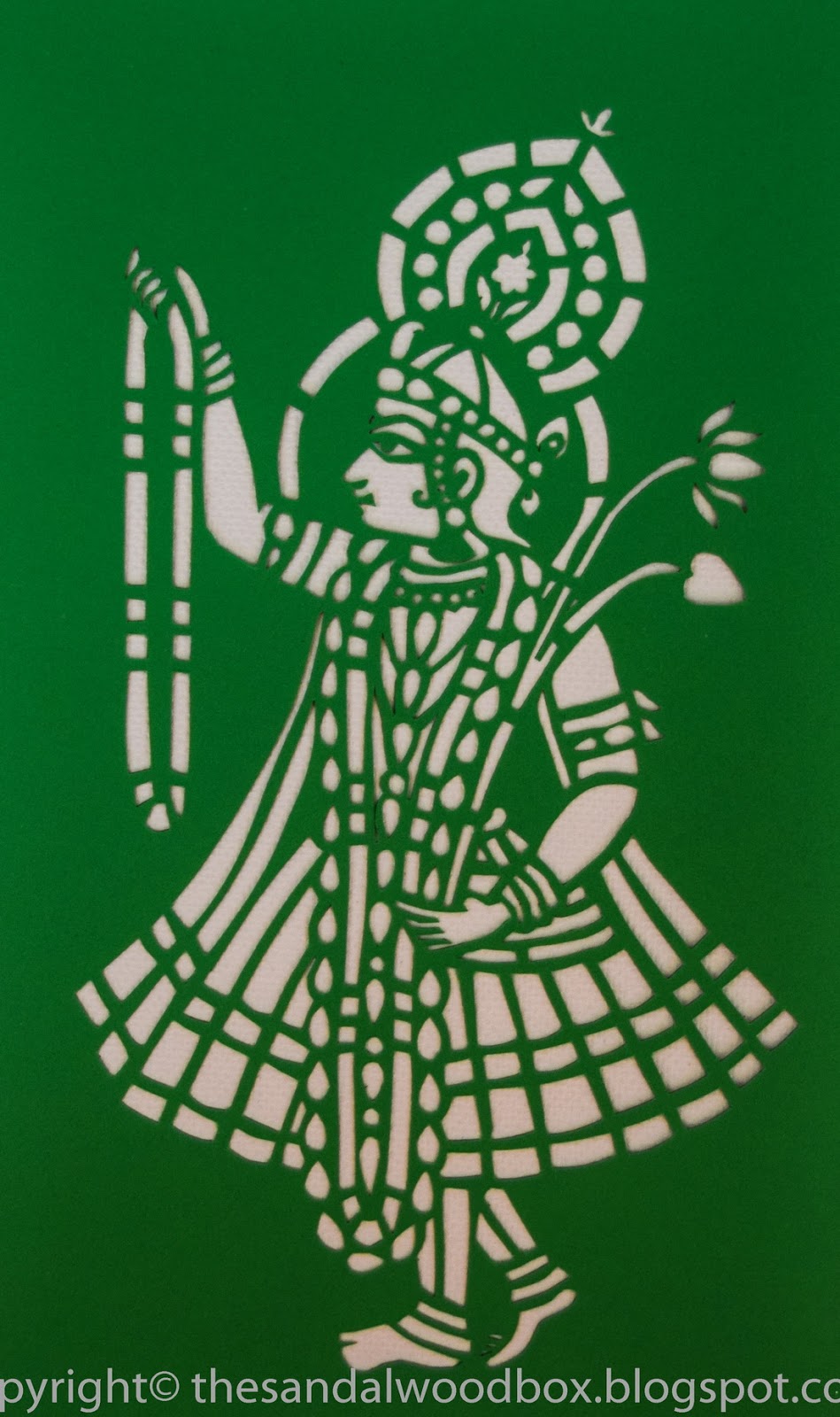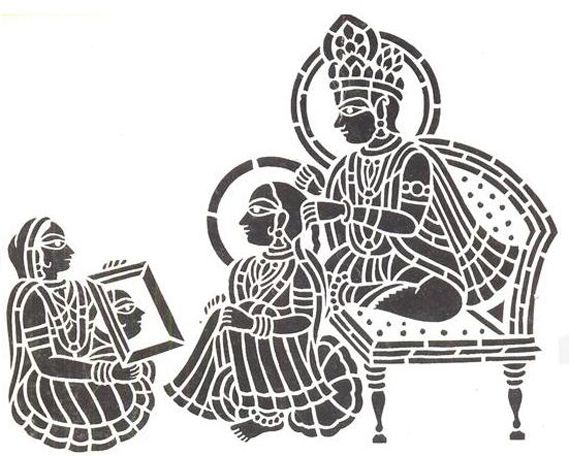ॐ श्री गुरुभ्यो नमः ॐ श्री शिवानन्दाय नमः ॐ श्री चिदानन्दाय नमः ॐ श्री दुर्गायै नमः
Source of all Images in this Blog-post : Google Images : ‘Google Image Search’ will reveal the multiple sources of every single image shared in this Blog. For more details, kindly see ‘Disclaimer‘

Introduction
Sanjhi art, an ancient folk art form from Mathura, Uttar Pradesh, is a unique blend of cultural heritage and artistic finesse. Originating in the temples of Vrindavan, this art form dates back to the 16th century and has since evolved, representing the divine love of Radha and Krishna through intricate hand-cut paper designs.
Historical Roots and Cultural Significance
Sanjhi, derived from the word ‘Sanjh’, meaning evening, is traditionally associated with the worship of Radha and Krishna. Initially, priests and temple artists created these designs as a ritual offering during the festival of Pitru Paksha, dedicated to deceased ancestors. The art was believed to help devotees attain a spiritual connection with the divine through its meditative creation process.
The themes in Sanjhi art are predominantly centered around the leelas (divine plays) of Krishna, showcasing scenes from his life, the flora and fauna of Vrindavan, and intricate geometrical patterns symbolizing the universe. This art form reflects the strong cultural and spiritual ethos of Mathura, serving as a reminder of the city’s rich mythological past.
Gilmpses of Sanjhi Art of Vrindavan through Google Images

The Artistic Process: Intricacy and Precision
Sanjhi art is distinguished by its meticulous process and the precision required in execution. The primary material used is paper, often tinted with natural dyes, on which the artists carefully sketch the desired designs. The process of cutting these designs is painstaking, demanding steady hands and intense concentration. Traditionally, artisans used a fine, sharp tool called ‘Kalam’ to etch out the delicate patterns.
The complexity of designs varies, ranging from simple geometric patterns to elaborate depictions of Radha-Krishna’s stories. The cut-out patterns are then used as stencils to create impressions on water, walls, and floors, often accompanied by the placement of flowers, diyas (oil lamps), and rangoli (colored powder) to enhance the aesthetic appeal.

Evolution and Contemporary Relevance
While Sanjhi art began within the confines of temples, it has gradually found its way into the mainstream, thanks to the efforts of local artisans and cultural enthusiasts. Contemporary artists have embraced this traditional art form, experimenting with new materials, themes, and formats, thus keeping it relevant in modern times.
Artisans have started using Sanjhi art in various commercial products like lampshades, decorative items, and wall hangings, making it accessible to a broader audience. Moreover, workshops and exhibitions are organized regularly to educate people about this art form, ensuring its survival and continued relevance.
Sanjhi’s evolution has seen its stencils, once solely used for rangolis, gain prominence as art pieces in their own right. These cutouts, now framed and cherished, are as revered as the final decorative displays they create.

Gilmpses of Sanjhi Art of Vrindavan through Google Images
Tools and Techniques: The Essence of Craftsmanship
Sanjhi Art, originating from Mathura, India, is a traditional craft distinguished by its intricate paper cuttings, often depicting mythological scenes and motifs. The essence of Sanjhi craftsmanship lies in its unique tools and techniques.
Central to this art form is the ‘Kalam,’ a specialized cutting tool, which artists wield with exceptional skill to create delicate patterns. The artistry also involves using fine brushes for applying natural dyes, a practice that highlights the intricate designs. Artists use specific types of paper, chosen for their texture and durability, to withstand the detailed cutting and dyeing processes.
Before the actual cutting begins, meticulous sketching forms the blueprint of the final artwork. This pre-cutting sketching is a critical step, ensuring precision in the complex designs. The creation of stencils is another pivotal technique, allowing for repetitive patterns and symmetry in the designs.
Together, these tools and techniques exemplify the depth of skill and tradition inherent in the Sanjhi Art of Mathura, making it a remarkable embodiment of Indian craftsmanship.

Symbolism and Motifs: Decoding the Art
Sanjhi Art from Mathura is not merely an aesthetic creation but a rich tapestry of symbolism and motifs deeply rooted in spiritual and philosophical contexts. Central to this art form are motifs like peacocks and lotuses, and depictions of Lord Krishna’s life, each embodying profound meanings.
The peacock, with its splendid plumage, symbolizes beauty and awakening, while the lotus represents purity and spiritual enlightenment, thriving in muddy waters yet untouched by its impurities.
Scenes from Krishna’s life in Sanjhi Art illustrate various aspects of devotion, love, and the cosmic play of the divine. These motifs go beyond mere decoration, serving as visual metaphors that bridge the human and the divine, offering insights into a culture that sees the divine in every aspect of life and nature.
A Visual Treat of Sanjhi Art of Uttar Pradesh through YouTube Videos

Sanjhi Art in Daily Life and Festivals
Sanjhi Art, originating from Mathura, is intricately woven into the daily lives and festive celebrations of its people. This art form, particularly revered during festivals like Diwali, transforms homes and temples into vibrant tapestries of cultural expression.
In homes, floors and walls are adorned with Sanjhi motifs, creating a festive ambiance that blends spirituality with aesthetics. The intricate designs, often depicting scenes from Krishna’s life or nature-inspired elements, are believed to bring good fortune and divine blessings.
In temples, Sanjhi Art becomes a focal point of devotion, enhancing the spiritual experience of devotees. Its presence in religious ceremonies underscores its significance in not just beautifying spaces but also in elevating the spiritual ethos of rituals and celebrations, making it an inseparable part of the cultural and religious fabric of Mathura.

The Global Footprint: Sanjhi Art Beyond Borders
Sanjhi Art, with its roots in Mathura, has transcended geographical boundaries, garnering international acclaim and evolving into a global art phenomenon. This art form has captivated audiences worldwide through exhibitions in prominent global cities, showcasing its intricate designs and profound cultural significance.
International collaborations have further enriched Sanjhi Art, infusing it with diverse artistic perspectives while preserving its traditional essence. Its adaptability and universal appeal are evident as artists globally draw inspiration from its motifs and techniques, integrating them into contemporary art forms.
Sanjhi Art’s global footprint is a testament to its timeless beauty and its ability to resonate across cultures, making it a unique and cherished contribution to the world’s artistic heritage.

Educational Initiatives and Workshops
Educational initiatives and workshops play a crucial role in revitalizing and spreading awareness of Sanjhi Art. Across various regions, organizations and individual artists conduct workshops aimed at preserving this traditional art form. These sessions attract a diverse audience, ranging from art enthusiasts to students and cultural scholars, eager to learn about the intricate techniques and rich history of Sanjhi. Through hands-on experience and expert guidance, participants gain a deeper appreciation of the art, contributing to its contemporary relevance. These educational efforts not only help in keeping the tradition alive but also in fostering a new generation of artists and admirers, ensuring the longevity and continuous evolution of Sanjhi Art in the modern world.
Future Perspectives: Innovations and Adaptations
The future of Sanjhi Art hinges on a delicate balance of tradition and innovation. Interviews with avant-garde artists reveal a trend of pushing traditional boundaries, incorporating new materials and blending Sanjhi motifs with contemporary art styles. This evolution is not without challenges, particularly in the digital age, where maintaining the art’s essence while appealing to modern tastes requires creative ingenuity.
Artists are exploring digital mediums to reach a broader audience, while simultaneously striving to retain the art’s intricate handcrafted beauty. These adaptations are crucial for Sanjhi Art’s survival and relevance in a rapidly changing world.
The art form’s ability to evolve while preserving its core identity will determine its place in the future landscape of global art, making it a fascinating subject for those interested in the intersection of cultural heritage and contemporary artistic expression.


A Visual Treat of Sanjhi Art of Uttar Pradesh through YouTube Videos
Challenges and the Way Forward
Despite its rich heritage, Sanjhi art faces challenges such as the dwindling number of traditional artists and a lack of sufficient patronage. The intricate and time-consuming nature of the craft makes it a less lucrative option for the younger generation, who often opt for more financially rewarding careers.
To preserve this exquisite art form, there is a need for concerted efforts from the government, cultural organizations, and art enthusiasts. Providing financial support, organizing training programs for young artists, and promoting Sanjhi art at national and international platforms can play a crucial role in ensuring its survival and prosperity.

Sanjhi Traditional Art of Mathura in Uttar Pradesh

Conclusion
In conclusion, Sanjhi art, with its rich tapestry of history and devotion, stands as a beacon of India’s cultural and spiritual heritage. From the sacred streets of Mathura and Vrindavan to the hallowed halls of temples, this art form weaves a narrative that transcends mere aesthetic appeal.
Sanjhi is a symphony of faith, a dance of devotion, capturing the essence of Lord Krishna’s legends in every delicate cut and color. As dusk falls, Sanjhi comes alive, not just as a visual spectacle but as a spiritual journey, inviting onlookers into a world where art and devotion merge seamlessly. In its intricate patterns and careful craftsmanship lies the heart of a tradition that continues to enchant, inspire, and connect generations to the divine.
Sanjhi is more than an art form; it is a living testament to the enduring beauty and profundity of Indian cultural legacy, a legacy that continues to illuminate the path of spirituality through its mesmerizing artistry.

7 replies on “Sanjhi Art of Mathura in Uttar Pradesh : The Art of Hand Cut Paper Designs”
wow amezing
lovelly
.
Hello….
I am Sanjay from Mumbai. I am interested in Sanjhi Art Form, to know, learn and even buy some authenticated & genuine Art-pieces
One of my companies is also into converting Physical Art Forms into Digital and also minting the digital form as NFT for the World Wide Audience.
May I get the preliminary details about Sanjhi Art Forms and also the details about few artists practising the Sanjhi Art Forms!
Please feel free to contact me to know about our interest in converting authentic Art forms into Digital Form and also as NFTs
Thanks & Regards
Sanjay V Sheth
Hello Sanjay, I work for a company called EkiBeki that mints traditional Indian art as NFTs including Sangi! Feel free to reply if you would like more information.
Hi want to know about sanjhi in details
I have done so many art work on computer of sanjhi art I can do manually also I can cut any small detais manually but people should work with time I had done my exhibition of digital sanjhi art